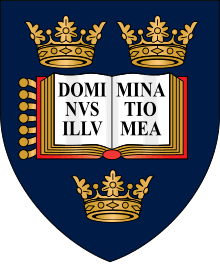St Peter's College, Oxford
| St Peter's College | |||||||||||||||||
|---|---|---|---|---|---|---|---|---|---|---|---|---|---|---|---|---|---|
| Oxford | |||||||||||||||||
|
| |||||||||||||||||
 Blazon: Per pale vert and argent, to the dexter two keys in saltire or surmounted by a triple towered castle argent masoned sable and on the sinister a cross gules surmounted by a mitre or between four martlets sable, the whole within a bordure or. | |||||||||||||||||
|
| |||||||||||||||||
| Location | New Inn Hall Street | ||||||||||||||||
| Coordinates | 51°45′10″N 1°15′39″W / 51.752762°N 1.260721°WCoordinates: 51°45′10″N 1°15′39″W / 51.752762°N 1.260721°W | ||||||||||||||||
| Latin name | Collegium Sancti Petri-le-Bailey | ||||||||||||||||
| Established | 1929 (attained full college status in 1961) | ||||||||||||||||
| Named for | Saint Peter | ||||||||||||||||
| Previous names | St Peter's Hall (1929–1961) | ||||||||||||||||
| Sister college | None | ||||||||||||||||
| Master | Mark Damazer | ||||||||||||||||
| Undergraduates | 342[1] (2011/2012) | ||||||||||||||||
| Postgraduates | 130 | ||||||||||||||||
| Website |
www | ||||||||||||||||
| Boat club | Boatclub | ||||||||||||||||
| Map | |||||||||||||||||
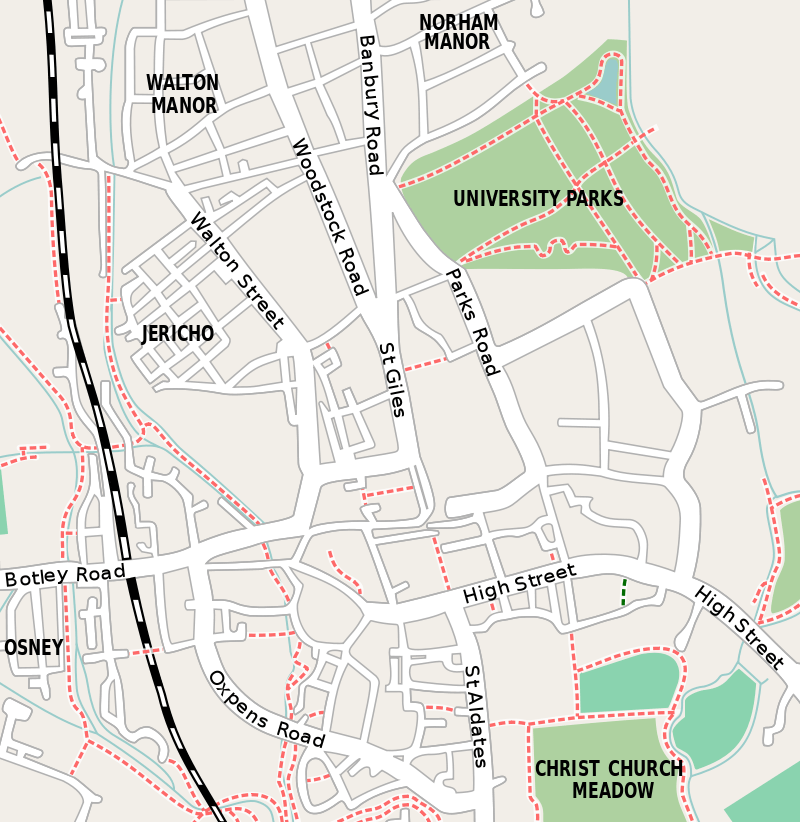 Location in Oxford city centre | |||||||||||||||||
St Peter's College is one of the constituent colleges of the University of Oxford and is located in New Inn Hall Street, Oxford, United Kingdom. It occupies the site of two of the university's medieval halls, dating back to at least the 14th century. The modern college was founded by Francis James Chavasse, former Bishop of Liverpool, opened as St Peter's Hall in 1929, and achieved full collegiate status as St Peter's College in 1961. Founded as a men's college, it has been coeducational since 1979.[2]
As of 2016, the college had an estimated financial endowment of £40.3 million.[3]
History
St Peter's occupies the site of two of the university's medieval halls or hostels for students: Trilleck's Inn, later New Inn Hall, and Rose Hall. Trillecks' Inn was founded in the 14th century by Bishop Trilleck and, as New Inn Hall, merged into Balliol College in 1887. Rose Hall was given to New College by William of Wykeham. New College finally sold the site to the rector of St Peter-le-Bailey in 1859 and 1868 as a site for a new church, now the college chapel.[4]
The history of the college in its present form began in 1923 when Francis James Chavasse, former Bishop of Liverpool, returned to Oxford. He was concerned at the rising cost of education in the older universities in Britain, and projected St Peter's as a college where promising students, who might otherwise be deterred by the costs of college life, could obtain an Oxford education. In 1928 St Peter's Hall opened as a hostel with 13 residents.[5] In 1929 it was recognized by the university as a Permanent Private Hall and in 1947 as a New Foundation.[4]
In 1961, the university approved a statute giving St Peter's Hall full collegiate status. With the granting of its royal charter in the same year, it took the name St Peter's College.
The colours of the college are green and gold.
Buildings
St Peter's has a varied set of buildings, many of them much older than the college itself. The college has, in effect, adapted existing buildings to provide the collective facilities needed for college life, and built new ones to provide student accommodation.
Older Buildings
Linton House, a Georgian rectory dating from 1797, is the entrance to the college and houses the porters' lodge and college library. Canal House, the master's lodge, dates from the early 19th century.
The college chapel was originally the Church of St Peter-le-Bailey, built in 1874, and the third church of that name on or close to the site. The chapel is filled with memorials to members of the Chavasse family, including Captain Noel Chavasse's original grave cross, the Chavasse memorial window and a large bas-relief of Bishop Francis Chavasse at prayer.[6]
The college dining hall, known as Hannington Hall after the Victorian missionary Bishop James Hannington, dates from 1832 and is the only surviving part of New Inn Hall. The Chavasse Building, formerly the Central Girls' School, which adjoins the original site of the college, was acquired more recently and provides living accommodation for students, seminar rooms, a Middle Common Room (MCR) for postgraduates, and a music room.
Accommodation
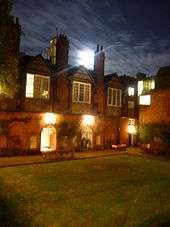
The college has four quads: Linton Quad (the main quad), Mulberry Quad, Hannington Quad and Chavasse Quad. On site, students are housed in the modern New Block, the Chavasse building, Staircase IV, the Matthews block (this latter building also housing a spacious JCR and student-run bar) and the Morris Building. Fellows and college staff occupy rooms mostly in Staircases I-IV and the Latner building.
St Peter's also has a few off-site accommodation blocks for students, a few minutes away from the main college site. St Thomas' Street and St George's Gate house undergraduates, while Paradise Street (which was officially opened in June 2008) houses postgraduates and fourth-year undergraduates.
Student life
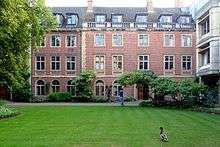
The student-run Junior Common Room organises a wide variety of social events throughout the academic year, ranging from formal events to celebrate such things as Burns Night (complete with haggis and poetry) to creatively themed parties that run into the early hours of the morning. The college is one of the few to feature its own student-edited arts magazine, Misc, which is published termly.
Sports
The college has sports teams competing in rowing, cricket, football, table football and rugby. It shares with Exeter and Hertford Colleges a sports field which has two cricket pitches and pavilions, two rugby and football pitches, a hockey pitch, tennis courts and a squash court.[7]
Rowing is a popular sport: the college boat club, St Peter's College Boat Club, competes regularly. The club shares a boathouse with Somerville College Boat Club, University College Boat Club and Wolfson College Boat Club. The club has had a number of successes in recent years.
Railway engine
Taking the original name of the college, GWR 6959 Class steam locomotive no. 7900 was built in 1949 for British Railways and named "Saint Peter's Hall" (no abbreviation). One of the brass nameplates from the now-scrapped locomotive survives in the college.
People associated with the college
Masters
- Christopher Maude Chavasse (1929)
- Julian Thornton-Duesbery (1940–1944 and 1955–1968)
- Robert Wilmot Howard (1945–1955)
- Alec Cairncross (1969–1978)
- Gerald Aylmer (1979–1991)
- John Barron (1991–2003)[8]
- Bernard Silverman (2003–2009)
- Mark Damazer (2010–present)
Notable alumni
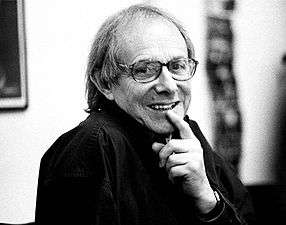 Ken Loach, English film and television director
Ken Loach, English film and television director David Davies, former Executive Director of The Football Association
David Davies, former Executive Director of The Football Association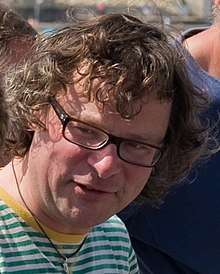 Hugh Fearnley-Whittingstall, celebrity chef and television personality
Hugh Fearnley-Whittingstall, celebrity chef and television personality.jpg) Mark Carney, Governor of the Bank of England
Mark Carney, Governor of the Bank of England Lord Condon, former Commissioner of the Metropolitan Police
Lord Condon, former Commissioner of the Metropolitan Police.jpg) Hugh Dancy, actor and model
Hugh Dancy, actor and model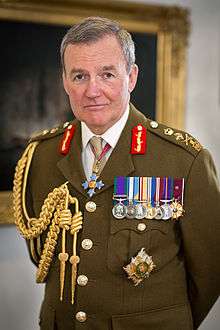 Nick Houghton, former Chief of Joint Operations, British Armed Forces
Nick Houghton, former Chief of Joint Operations, British Armed Forces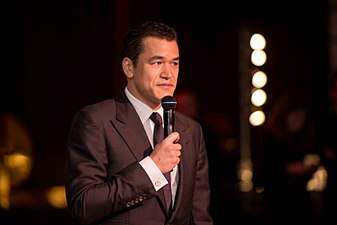 François Perrodo, entrepreneur and President of the energy company Perenco
François Perrodo, entrepreneur and President of the energy company Perenco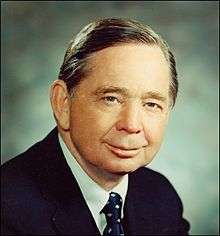 Carl Albert, former Speaker of the United States House of Representatives
Carl Albert, former Speaker of the United States House of Representatives
- Guy Arnold, explorer, traveller, polical commentator, Africa expert and writer
- Wilbert Awdry, creator of Thomas the Tank Engine
- Simon Beaufoy, writer of the screenplay for the films The Full Monty and Slumdog Millionaire
- Graham Bell, Canadian academic, writer and evolutionary biologist
- Michael Blomquist, American rower and former world champion
- Mike Carey, author
- Mark Carney, Governor of the Bank of England
- Paul Condon, Baron Condon, Commissioner of the Metropolitan Police from 1993 to 2000
- Gordon Corera, BBC security correspondent
- Kenneth Chan Ka-lok, member of the Hong Kong Legislative Council
- Noel Chavasse, Twice awarded the Victoria Cross
- Peter Dale, poet
- Jamie Dalrymple, Middlesex, Glamorgan and England cricketer
- Hugh Dancy, actor
- David Davies, football administrator
- Jack Dormand, later Baron Dormand of Easington, Labour MP for Easington, 1970–87
- David Eastwood, Vice-Chancellor of the University of Birmingham
- Hugh Fearnley-Whittingstall, chef and TV presenter
- Paul S. Fiddes, former principal of Regent's Park College, Oxford
- Matt Frei, BBC Washington correspondent
- Geordie Greig, editor of Evening Standard
- Robert Hanson, financier[9]
- Andy Hornby, chief executive of Coral, former chief executive of HBOS
- Rex Masterman Hunt, Governor of the Falkland Islands
- David Moxon, former Archbishop of New Zealand
- Martin Ivens, acting editor-in-chief of The Sunday Times
- Kurt Jackson, painter
- Libby Lane, Bishop of Stockport, first woman consecrated a bishop in the Church of England
- Ken Loach, film and television director
- Richard Lloyd Parry, Asia Editor, The Times of London
- François Perrodo, President of the energy business Perenco
- John Pritchard, Bishop of Oxford (2007–2014)
- Paul Reeves, former Archbishop of New Zealand and Governor-General of New Zealand
- Gareth Russell, author
- Dominic Shellard, Vice-Chancellor of De Montfort University
- Mark Stanhope, First Sea Lord and Chief of Naval Staff
- Christopher Tambling – (1964–2015) Composer, Organist and Choirmaster
- Jigyel Ugyen Wangchuck, current heir to the throne of Bhutan
- William Wickham (1831–1897), MP for Petersfield
- Daniel Woolf, Principal and Vice-Chancellor of Queen's University, Canada
- Ben Wright, BBC political correspondent
- Helen Lewis, New Statesman deputy editor
See also
- Category:Alumni of St Peter's College, Oxford
- Category:Fellows of St Peter's College, Oxford
References
- ↑ "Undergraduate numbers by college 2011–12". University of Oxford.
- ↑ "College History | www.spc.ox.ac.uk". www.spc.ox.ac.uk. Retrieved 2018-05-04.
- ↑ "College finances 2016" (PDF).
- 1 2 "A History of the County of Oxford: Volume 3: The University of Oxford". British History Online. Retrieved 16 August 2018.
- ↑ Chavasse, Christopher (8 November 1930). "St Peter's Hall, Oxford". The Times: 8. Retrieved 29 August 2013.
- ↑ http://www.spc.ox.ac.uk/content/chavasse-family-papers
- ↑ Sports – St Peter's College, University of Oxford Archived 9 May 2013 at the Wayback Machine.
- ↑ "Obituary". The Times. 29 August 2008. Retrieved 13 March 2010.
- ↑ Profile – Robert Hanson in The Yorkshire Post dated 29 March 2011. Retrieved 11 May 2017
External links
| Wikimedia Commons has media related to St Peter's College, Oxford. |
- St Peter's College – official website
- St Peter's College Middle Common Room
